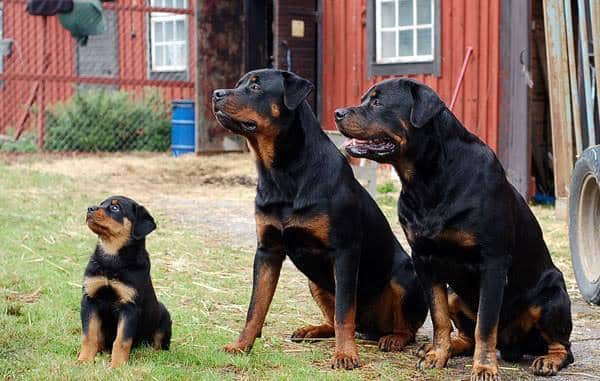The Rottweiler breed is an ancient one that has evolved a lot over the centuries. The breed developed from several Mastiff-like breeds and was used for heavy-duty tasks like herding and guarding. They even looked different back then. They were more valued for their abilities and their looks took a secondary place. It was important that they had the right temperament and build. They were bred to be working dogs. The only thing that mattered was that they should be able to perform their duties.
The characteristics for which they were favored are still there in the modern-day Rottweiler breed though they might look different. They were courageous, intelligent, strong, athletic, and fiercely loyal.
The German Rottweiler club, the Allegmeiner Deutscher Rottweiler Klub (ADRK) has been at the forefront for the protection of Rottweilers. Based in Stuttgart, Germany, ADRK had been established in 1921 and has fiercely protected the breed standards since then.
Their stringent norms have ensured that people look up to the ADRK to know what the Rottweiler stands for as a breed. The Rottweiler has changed a lot in terms of look over the past century. They were much lighter and shorter in the nineteenth century.
The height, as stipulated by the ADRK, is between 24 inches and 26 inches. The weight, preferably, should be between 105 and 120 pounds, with females on the lighter end of the scales.
The Rottweiler has a short double coat which is straight and coarse. The outer coat is of medium length, and shorter at the ears, head, and legs. The undercoat is around the thighs and neck. The coat that the Rottweiler breed has depends on the climate of the place where they live.
The Rottweiler is almost always black with specific brown markings over the eyes, on either side of the muzzle, chest, legs and beneath the tail. There are also tan lines on the toes.
There was a slew of differently colored breeds in the 19th century including red, brown, blue, and brindled. Even patches of white were seen while the coat was a lot thicker. There is still the occasional red Rottweiler, which is a combination of brown and mahogany, with the color black being absent.
Temperamentally a trained and sociable Rottweiler breed is calm, confident, and watchful. They are typically aloof to strangers though they are not openly hostile if well-trained. They will never back down from a threatening situation, especially if they think that a family member is in danger.
Read: German Rottweiler Pups: Products Of A Breeding Standard That Sets Them Apart From The Rest
This natural instinct to protect their family goes alongside their natural playfulness when they are with the family. They love children and can be quite goofy.
Everything that is good about the Rottweiler is in part helped by the intense training that they grow with. They need both physical and mental training. Socialization is an important part of their training so that they do not become too protective or aggressive. Indiscriminate breeding has been the bane of the Rottweiler breed. Poor standards led to the breeding of poor specimen that had neither the physical attributes of the Rottweiler nor the temperament for which there are so famous. They still remain near the very top of the popularity list of the American Kennel Club.


